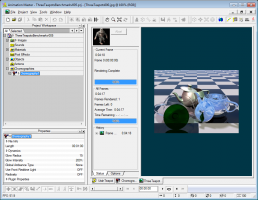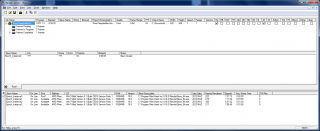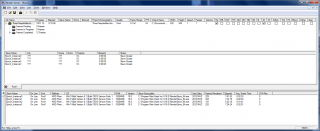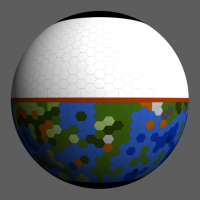
MMZ_TimeLord
Craftsman/Mentor-
Posts
1,495 -
Joined
-
Last visited
Content Type
Profiles
Forums
Events
Everything posted by MMZ_TimeLord
-
Good job... Are we going to see him in action?
-
All I can say is ... HAHAHAHAHAHAHAHAAAA!
-
Spline continuity and connecting splines
MMZ_TimeLord replied to robcat2075's topic in A:M Tutorials & Demos
I'm in... where do I send my money? -
John, Basically, yes. But, to qualify that statement, remember that there were FOUR threads or nodes running. So if you multiply that 1:16 by 4, you still end up with over 5 minutes a frame. BUT, by dividing the workload, you can reduce the overall render time of the entire sequence. Example: 120 frames rendered in A:M or with only one Node at 4 minutes a frame is (4x120=480 minutes) 8 hours. Where if you have four nodes running and each frame takes 5 minutes in each node, you get (5*120 / 4 = 150 minutes) 2 hours 30 minutes. This reduces the overall render time by 5 hours and 30 minutes. Again, your mileage may vary as well as your RAM usage. If the frames have a LOT of texture maps, then you will have to be very conscious of the RAM usage per node. With 16GB available, I could run upwards of 2 or 3 GB per node before there would be issues.
-
Well, I re-rendered this evening for giggles. On A:M V16.0b (64 bit) - Render time 04:18. I had a browser open and a bit under 3.4 GB of RAM used. CPU Usage was 18-20% during the course of the render. Here are the screenshots of the render in A:M and of my CPU meter during the render. . On NetRender (64 bit) with a single node - Render time 04:30 Same browser open and same pages. A bit under 3.5GB of RAM used. CPU Usage was 18-20% during the course of the render. Here are the screenshots of the completed NetRender and the CPU meter during the render. . So the rule seems to be - One frame = One core's worth of Processing with A:M. BUT even with NetRender it was distributed. I had not forced an affinity on each node for a specific core. For fun, I ran the same test with frame 0-11 rendered with NetRender (64 bit) and four nodes (64 bit) (my limit). This should give a better average render number per frame. Total Time = 15:06 ... Average time per frame = (15:06 *60 / 12 /60) = 01:15.5 Same browser open and same pages. RAM usage went up to a bit under 3.6GB. CPU Usage jumped to a 68%-70% level during the course of the render. Here are the screenshots of the completed NetRender and the CPU meter during the render. . Granted this was with a four node limit. Imagine the possibilities with, say, twenty nodes across four or five machines.
-
Oooooo.... Ahhhhhh... Purdy...
-
Yup, can't wait to see more... Great Job!!! Keep going!
-
Looks like a good start to me. Don't forget to back stuff up in more than one location. Dual-Layer DVDs are wonderful for directory or project backups. Cheers!
-
What Nancy showed there is pretty much how I've organized my stuff. Here's my main "My Animation Master" directory. I've also given the models directory structure for reference. Actions Choreographies Examples HDRI Image - Rendered Frames Images - Displacement Images - Foliage Masks Images - Other Masks Images - Signage Images - Skys & Backgrounds Images - Space Backgrounds Images - Textures Images - Water Libraries Materials Models Actors AM Bootcamp Animals Backgrounds Bridges and Highways Buildings Dinosaurs Planets Plants polygon models Primitives Props Tools TSM_characters TWO Project Vehicles Post Effects Projects Reference Material Render Pools Rigs Skylights Sound Effects Tutorials
-
Make them swing from their iPod ear buds... LoL
-
Nicely done Serg! I love the toon shading as well as the overall effect. Great Job!
-
itsjustme, Not sure if it would help or hurt, but in the project I posted, there is a ball rig that really helped me. I made it, I admit, and it's probably limited. It did however let me rotate the ball while keeping the squetch direction constant. i.e. - the ball could be squetched a certain direction WHILE it was spinning. Hope it comes in handy for someone.
-
I have to agree with robcat in that a lot of animators fail to see or grasp the significance of "weight" or "mass" in a character's motion. They may have a very technically correct motion, but no feeling of mass, flexibility (joints) and inertia of other parts of the character. When someone gets hit in the stomach with a fast moving cannon ball, they don't just fly backwards. The torso bends in response to the impact, dragging the other two halves of the body with it as it is pushed away. When a heavy character walks vs. a skinny character. Lumbering vs. lithe and limber. Bouncing balls give a VERY basic tool to understanding mass. I can animate two balls exactly the same size, texture and color. If I then change the way they are both animated, you SHOULD be able to tell which one is more flexible, light and bouncy vs. the one that is more stiff, heavy and resistant to bouncing. I struggled with the "non-living" example I posted earlier for quite a while before I began to 'get it'. It's very basic, simple and an excellent starting lesson for anyone who is beginning animation. You don't just put a beginning driver behind the wheel and hand them the keys. They need basic concepts and rules before ever starting that engine.
-
William, Since the original IP is yours, I would suggest that any additions to your resources are sent to you for approval. Sort of like a set director approval, etc. Once approved, then the resource could be put into the 'Bible' and others can utilize the same resources for their part of the story or side story. This will benefit those creating with you as well as you as the originator of the IP. Do you plan on keeping license of all the IP resources, yours and contributed? I would have no problem at all agreeing to that as you are offering a base for people to work in. Thoughts? By the way, I too am interested in helping with your story and props. I'm on Skype under mmz_timelord.
-
Happy Birthday Mark!
-
Happy Birthday John!!!
-
I found my AM Bootcamp Project while looking for something else last night... Here are my two favorite results from that project. One is a two, non-alive, ball bounce against a perpendicular surface. TwoBallsBounce.mp4 Next is a two, alive, ball interaction sequence. TwoBallsInteract.mp4 If anyone wants the project I've included it here. Some of the results, to me, could still use lots of polish. AM_Bootcamp_Level1_v16_.prj Enjoy!
-
Well, I bumped into this when I was about ready to use A:M to render out an image sequence as a rotoscope in a new choreography. Import your image sequence by right clicking the images section of the project work space and select Import... -> Animation or Image Sequence. Browse to your rendered frames from NetRender or A:M and select the lowest numbered one. i.e. - testrender000.png Then when they are all imported, right click the image and select "Save Animation as..." In the Save Animation As window click the button with the three dots in it to choose your path and file type. (...) I chose AVI as my output with uncompressed frames. (Changed in with the "Compression" button) After it saved, I used Handbrake to compress it with H.264. (You could probably do this all with QuickTime Pro, but i don't have it) Let me know if this is clear as mud... and I'll update it. Sample animation below... HoverTaxiTest001.mp4
-
Nicely done... any more? or is it just a test?
-
As far as I know A:M can only use one thread/renderer per frame. A:M itself or NetRender can NOT break down a single frame into multiple parts as far as I know.
-
Excellent work! Your research seems very complete. I was and still am a big fan of the original series as well as a few of the newer ones. This is looking better all the time!
-
okay trying out tool walking rough test
MMZ_TimeLord replied to johnl3d's topic in Tinkering Gnome's Workshop
Better... I think the Hammer's head swinging back and forth could be a bit slower and in time with his steps, kind of like a person bobbing their head back and forth as they step. The best of the two Screwdrivers is the Phillips. His head swings in time with his hopping motions. The Flat Head Screwdriver is about twice as fast with the head swinging as with his steps... looks all wrong. Think of how people in a sack race hop. My 2 pennies... -
Threw this together for fun...
MMZ_TimeLord replied to MMZ_TimeLord's topic in Work In Progress / Sweatbox
Okay, another update. I'm done with checking the books for reference on the hexagons that were mentioned. Now I'm just painting random on my own. Hope to start on the Northern hemisphere tomorrow, then start blending and making it all a bit more organic. Enjoy! -
Welcome to the A:M Forum! Introduce / Reintroduce Yourself
MMZ_TimeLord replied to Rodney's topic in New Users
My name is Jody and I've been using Hash's Animation:Master back in the day when it was Playmation on floppy disk. (1992) I had always interested in 3D animation, ever since I went to see Disney's TRON back in 1982 and even tried to code my own 3D engine on my Commodore (commode-door) 64 when I was 15. I've upgraded consistently almost every year for A:M with the dongle (non-expiring license) and am now happily on V16 Web subscription. Being part of the A:M community is truly fun and an honor to see so many different styles and types of 3D Animation. Working with Martin and his crew on the TWO project was extremely enjoyable. I missed out on SO unless it's still under production, but hope I can work on another project like TWO soon. Modeling and character animation are probably my two strongest points. Texturing and lighting still need lots of work for me to feel I've learned them well. I have not yet had the opportunity to work in the industry, but would love the chance to ease into it or find a niche that I could fit into while doing 3D animation. Hi, My name is Jody... and I'm an AMaholic... ("Hi Jody!" ) -
Threw this together for fun...
MMZ_TimeLord replied to MMZ_TimeLord's topic in Work In Progress / Sweatbox
itsjustme and thekamps, You guys got it, but I knew as soon as I released the name of the author it would be just a matter of Google seconds. thekamps, that image is WAY off, but a cute little attempt. Unfortunately, there are many mathematically verifiable contradictions in the books. Here's all my notes and what conclusions and decisions I came to for where to start the model. Enjoy. Maps and Mathematics of Jack L. Chalker's Well World 780 Southern Hexagons 780 Northern Hexagons 1560 Total Hexagons (p 62 [acronym="Midnight at the Well of Souls"]MatWoS[/acronym]) 614.86 km is the length across of each hexagon (p 88 [acronym="Midnight at the Well of Souls"]MatWoS[/acronym]) 355 km is the length of a side of each hexagon (p 62 [acronym="Midnight at the Well of Souls"]MatWoS[/acronym]) Avenue width: 35.5 meters or 1/10,000th of the length of a side of a hex (p 199 [acronym="Midnight at the Well of Souls"]MatWoS[/acronym]) Area of a Hexagon ½ x (6s) x h ½ x (6(355) x 307) note: h is the radius so it is half of 615 3,269,552^2 Area of a Hex. (This is roughly the size of India) 3,269,552^2 x 1560 (number of Hexes) 510,049,800^2 (projected area of Well World) Area of Well World is 5.1 x 10^8 km^2 (p 55 [acronym="Midnight at the Well of Souls"]MatWoS[/acronym]) 5.1 x 1,000,000,000 or 510,000,000^2 This is remarkably close to the surface area of the Earth which is 510,072,000^2 We are told that the hexes that border the equatorial barrier that separate the Northern from the Southern Hexes are “two hexes wide and half a hex tall” (p 287 [acronym="Midnight at the Well of Souls"]MatWoS[/acronym]). We are informed there are 24 such split hexagons. (p 71 [acronym="Quest for the Well of Souls"]QftWoS[/acronym]) This would mean there are only 12 avenues if 24 refers to the actual hexagons and not the pairs. If pairs, then 24 Avenues. No exact reference that I have found is given as to the width of the equatorial barrier, nor it's height. I will make it about 35 kilometers tall. 1/10 the height of a hexagon side. Lastly the occupied surface area of the Well World is not all of it. The text below refences large black polar caps. If all of this information is used along with the partial southern and northern maps to compile a model of the Well World, there is a serious contradiction of information. 1. 780 Southern and Northern Hexagons will NOT map in a strip 10 Hexagons high with the split hexagon spacing shown in the map. If we take the map as the more likely source, then the total count per side would be 800 hexagons. This would allow for 20 Avenues total. 2. If we use the 24 split Hexagon data, along with the 12 avenue model, then the total hexagon and area count drops significantly. Calculations show the total number of hexagons per hemisphere would be only 480. WAY too small to be the size stated in the book. If we use 24 Avenue model then the total number of hexagons rise to 960. This is quite a bit larger than the size in the book, but not out of the realm of possibility. 3. Either of the larger models, 20 or 24 Avenue, would result in a larger circumference than mentioned in Exiles at the Well of Souls, which was 40,000 km. No matter how you map the strip map onto a sphere, the southern most and northern most hexagons WILL be distorted. This is verified in the The Return of Nathan Brazil. (p 128 [acronym="The Return of Nathan Brazil"]TRoNB[/acronym]) If we base our calculations for the equatorial circumference, planet diameter and radius on the hexagon dimensions given above: (355 km on a side) 20 Avenue Model, 10 hexagon high hemispheres = 800 hexagon hemispheres, 42,600 km circumference, 13,560 km Diameter, 6,780 km Radius 24 Avenue Model, 10 hexagon high hemispheres = 960 hexagon hemispheres, 51,120 km circumference, 16,272 km Diameter, 8,136 km Radius Earth, as we know it today, has an approximate 40,074 km circumference, 12,756 km Diameter, 6,378 km Radius Subtracting the unoccupied area of the poles would still give us a nearly equivelant surface area to Earth. I would infer with these discrepencies, that the 20 Avenue model is likely to be our closest one without seriously distorting the overall size of the Well World. If we take the 24 Avenue model, then the total number of hexagons per hemisphere is VERY much in error as well as the size of the planet itself. Based on all this, I have begun modeling the Well of Souls based on the 20 Avenue calculations. Refence text: From Exiles at the Well of Souls: "Look-you got all those jewel faces on the south, but you can tell it's lots of green and ocean and stuff like that. Our kind of world. Then you got that great dark-amber strip around the equator, and then a whole different kind of world up top." "The poles are interesting, too," Gil Zinder noted. "See how dark and thick they are, and how huge. Almost like great buildings hundreds, maybe thousands, of kilometers across." "Finally clipped it a little low, got within the Well's influence, and got nonteched, same as the first one. The reason you haven't heard is that they had swung up North for a look. Near as we can tell, they went down in 1146 or 1318, Uchjin or Ashinshyh. Got anything on them?" From Quest for Well of Souls: A tall minotaur paused before the door, looking curiously for a moment at the symbol embossed on everything. Unlike his native Dasheen, which used a standard hexagonal symbol, Yaxa used an ideogram which he mistook at first for a pair of stylized wings. After a moment he realized that it was not so. Yaxa was a state along the Equatorial Barrier. It was composed of one half of a hex split horizontally joined to one half of a hex split vertically. Only twenty-four such hexes were so split on either side of the Barrier. The "wings" were, in fact, two half-hexes joined. From The Return of Nathan Brazil: Mavra smiled wanly. "Like anyplace else, really. Just imagine a planet that was a lot of little planets, fifteen hundred and sixty of them, in fact, each roughly six hundred and fifteen kilometers wide at the Well World's equator—they get a little distorted as you go toward the poles. Each one is shaped like a hexagon, the Markovians were nutty about the number six. Each one with its own plants, insects, you name it, and all with different dominant races. All the carbon-based ones are south of the equator, seven hundred and eighty in all. The ones north of the equator are non-carbon based. They can be anything."














